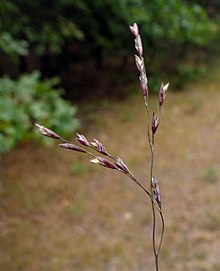Poa
| Poa | |
|---|---|

| |
| Poa annua(annual meadow-grass) | |
| Scientific classification | |
| Kingdom: | Plantae |
| Clade: | Tracheophytes |
| Clade: | Angiosperms |
| Clade: | Monocots |
| Clade: | Commelinids |
| Order: | Poales |
| Family: | Poaceae |
| Subfamily: | Pooideae |
| Supertribe: | Poodae |
| Tribe: | Poeae |
| Subtribe: | Poinae Dumort. |
| Genus: | Poa L.(1753) |
| Synonyms[1] | |
|
Synonymy
| |


Poa[2]is agenusof about 570speciesofgrasses,native to the temperate regions of both hemispheres. Common names includemeadow-grass(mainly in Europe and Asia),bluegrass(mainly in North America),tussock(someNew Zealandspecies), andspeargrass.Poa(πόα) isGreekfor 'fodder'.Poaare members of the subfamilyPooideaeof the familyPoaceae.[3][4][5][6][7]
Bluegrass, which has green leaves, derives its name from the seed heads, which are blue when the plant is allowed to grow to its natural height of two to three feet (0.6 to 0.9 meters).[8][9][10]
The genusPoaincludes bothannualandperennialspecies. Most aremonoecious,but a few aredioecious(separate male and female plants). Theleavesare narrow, folded or flat, sometimes bristled, and with the basal sheath flattened or sometimes thickened, with a blunt or hooded apex and membranaceousligule.[11][12][13]
Cultivation and uses
[edit]Many of the species are importantpastureplants, used extensively bygrazinglivestock.Kentucky bluegrass(Poa pratensis) is the most extensively used cool-season grass used inlawns,sports fields, andgolf coursesin the United States.[14]Annual bluegrass(Poa annua) can sometimes be considered a weed.[15]
According to second-century physicianGalen,the roots of certain species are good for treating fresh wounds and bleeding. In the sixteenth century,Poagrasses were used to treatinflammation of the kidney.[16]
Some of thePoaspecies are popular for gardens and for landscaping inNew Zealand.
Insect foodplant
[edit]Lepidopterawhose caterpillars feed onPoainclude:
- Agriphila inquinatella
- Cercyonis pegala(common wood-nymph)
- Poanes hobomok(Hobomok skipper)
- Poanes zabulon(Zabulon skipper)
Selected species
[edit]- Poa abbreviata– short bluegrass
- Poa affinis
- Poa alpigena– northern meadow-grass
- Poa alpina– alpine meadow-grass
- Poa alsodes– grove bluegrass
- Poa ammophila– sand bluegrass
- Poa angustifolia– narrow-leaved meadow-grass
- Poa annua– annual meadow-grass, annual bluegrass
- Poa arachnifera– Texas bluegrass
- Poa arctica– Arctic meadow-grass
- Poa arida
- Poa atropurpurea– San Bernardino bluegrass
- Poa badensis
- Poa balfourii
- Poa bigelovii
- Poa bolanderi
- Poa bulbosa– bulbous meadow-grass
- Poa chaixii– broad-leaved meadow-grass
- Poa chathamica
- Poa cita– silver tussock
- Poa clivicola- fine-leaved snow grass
- Poa colensoi– blue tussock
- Poa compressa– flattened meadow-grass
- Poa confinis
- Poa cookii– Cook's tussock
- Poa costiniana– bog snow-grass
- Poa curtifolia
- Poa cusickii
- Poa cuspidata
- Poa diaboli– Diablo Canyon bluegrass
- Poa douglasii– Douglas bluegrass
- Poa drummondiana
- Poa dura
- Poa ensiformis– sword tussock-grass, purple-sheathed sussock-grass
- Poa fawcettiae– horny snow-grass
- Poa fendleriana
- Poa flabellata
- Poa flexuosa– wavy meadow-grass
- Poa foliosa– muttonbird poa
- Poa glauca– glaucous meadow-grass
- Poa gunnii
- Poa hiemata– soft snow-grass
- Poa howellii
- Poa humilis– spreading meadow grass
- Poa infirma– early meadow-grass
- Poa iridifolia
- Poa kelloggii
- Poa kerguelensis
- Poa kunthii
- Poa labillardierei– common tussock-grass
- Poa leioclada
- Poa leptocoma
- Poa litorosa
- Poa macrantha
- Poa mannii
- Poa meionectes
- Poa mireniana
- Poa morrisii– soft tussock-grass
- Poa napensis– Napa bluegrass
- Poa nemoralis– wood meadow-grass
- Poa novarae
- Poa paludigena– bog bluegrass
- Poa palustris– swamp meadow-grass
- Poa paramoensis
- Poa poiformis– coast tussock-grass, blue tussock-grass
- Poa pratensis– smooth meadow-grass, Kentucky bluegrass
- Poa rodwayi
- Poa sandvicensis
- Poa secunda– alkali bluegrass, big bluegrass, Nevada bluegrass, pine bluegrass, Sandberg bluegrass, wild bluegrass
- Poa sieberiana– grey tussock-grass
- Poa siphonoglossa
- Poa subcaerulea– spreading meadow-grass
- Poa supina– creeping meadow-grass
- Poa trivialis– rough meadow-grass
- Poa unilateralis
References
[edit]- ^PoaL.Plants of the World Online.Retrieved 2 July 2023.
- ^From Greek πόα "grass, meadow."
- ^Flora of China Vol. 22 Page 257Trưởng thành sớm hòa thuộczao shu he shuPoaLinnaeus, Sp. Pl. 1: 67. 1753
- ^Flora of Pakistan
- ^Altervista Flora Italiana, generaPoaArchived2015-02-01 at theWayback Machineincludes photos and distribution maps for several species
- ^Soreng, R. J. & P. M. Peterson. 2012. Revision ofPoaL. (Poaceae, Pooideae, Poeae, Poinae) in Mexico: new records, re-evaluation ofP. ruprechtii,and two new species,P. palmeriandP. wendtii.PhytoKeys 15: 1–104
- ^"PoaL. "Plants of the World Online.Board of Trustees of the Royal Botanic Gardens, Kew. 2022.Retrieved23 January2022.
- ^What Makes Kentucky's Bluegrass Blue.New York Times.June 3, 1993.]
- ^Longhi-Wagner, H. M. 1987. Gramineae. Tribo Poeae, in Fl. Ilust. Rio Grande do Sul. Boletim do Instituto de Biociências, Universidade Federal do Rio Grande do Sul 41: 1–191
- ^Zon, A. P. M. v. 1992. Graminées du Cameroun. Wageningen Agricultural University Papers 92–1(2): 1–557
- ^Cabi, E. & M. Doğan. 2012. Poaceae. 690–756. In A. Güner, S. Aslan, T. Ekim, M. Vural & M. T. Babaç (eds.) Türkiye Bitkileri Listesi. Nezahat Gökyiğit Botanik Bahçesi ve Flora Araştırmaları Derneği Yayını, Istanbul
- ^Gibbs Russell, L. W., M. Koekermoer, L. Smook, N. P. Barker, H. M. Anderson & M. J. Dallwitz. 1990. Grasses of Southern Africa. Memoirs of the Botanical Survey of South Africa 58: i–ix,.
- ^Negritto, M. A. & A. M. Antón. 2000. Revisión de las especies dePoa(Poaceae) del noroeste argentino. Kurtziana 28(1): 95–136
- ^Dvorchak, Robert (June 13, 2007)."Oakmont-inspired Stimpmeter allows USGA to accurately measure speed, consistency of putting surfaces".Pittsburgh Post-Gazette.Retrieved2007-09-08.
- ^Ohlendorf, B.; Cudney, D. W.; Elmore, C. L.; Gibeault, V. A. (April 2003)."Annual Bluegrass Management Guidelines--UC IPM".University of California.Retrieved2007-09-08.
- ^Gerarde, John (1597)."The Herball or Generall Historie Of Plantes".Retrieved2009-01-11.
